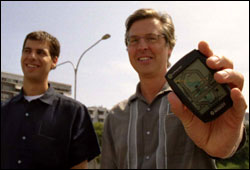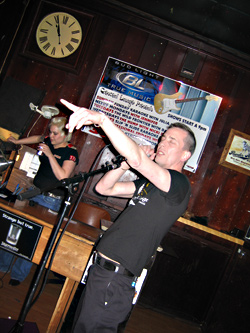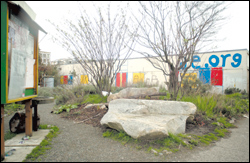FOR MANY CHIEF executive officers, the venture-capital offer sheet would have begged only one question: Where do I sign? But Ryan Peterson had a delicate corporate culture to preserve. He feared a massive infusion of cash would contradict the bootstrapping mentality that defined his company. “Every one of our employees knows what money’s worth and knows not to waste it,” says Peterson, founder and CEO of TrafficGauge. “If we hadn’t fought for this kind of growth, we wouldn’t have gotten this far.”
Rather than accept the venture-capital offer, Seattle-based TrafficGauge called on a group of local investorsangels, as they’re called in today’s hope-deprived economy. “With angels, I think there’s more control over your own destiny than with a VC,” says Eric Meyer, co-president of TrafficGauge. “We had to scrap for every penny.” Two weeks later, at the end of May, the company had raised enough for a June 13 product launch. Today, Seattleites can use the compass-sized TrafficGauge to stay informed of traffic jams on King County’s busiest highways.
TrafficGauge has learned to do more with less, embracing the new reality. Boeing is in decline, the state ranks highest nationally in company closings, and more than 100,000 jobs have been lost. The past four years have offered a sobering education in economic Darwinism. Startups now have two choices: scrap for every penny or die. The irrational exuberance of 1999 taught the industry that funding is secondary to entrepreneurial tenacity. Here are three Seattle-area companies that have taken that lesson to heart.
NERVANA
“Microsoft in ’75, Oracle in ’77, PeopleSoft in ’87. SAP. Very few good, solid software companies were started during the boom times. Cisco. They’re all recession companies.” Nosa Omoigui believes he’s in the right place at the right time as CEO of Nervana, the company he founded in April 2001, after six years with Microsoft. On July 21, Nervana received an early-stage investment from Bear Stearns that will propel the company into the enterprise software market. After more than two years of covert development, Nervana is poised to come out of “stealth mode” with the imminent launch of its Web site. Early conversations have generated excitement among potential customers in the company’s core pharmaceutical market.
Still, it has not been easy for Nervana. The conventional wisdom of how to build a software company has mutated.
“Everything got pulled from underneath me in real time,” Omoigui says. “Between VC meetings, the definition of early stage kept changing.”
In the 1990s, venture-capital investors gambled on companies that might fail, hoping for lucrative returns from the ones that succeeded. A startup with a strong patent and a large potential market provoked risky leaps of faith. Today’s VC investor waits for validation of a company’s business model, requiring a finished product or paying customers. With a raised barrier of entry, software entrepreneurs have to do more with less.
BOOTSTRAPPING IS nothing new to Omoigui. He provided seed capital to start Nervana and initially worked from home. In June 2002, he filed a 300-page patent and assembled a six-person team that could execute his vision, thanks in no small part to an angel investment by Nervana board member and former Microsoft executive Scott Oki. Now Nervana can make a run at capturing information technology’s Holy Grail.
For years, software companies have pursued an elusive concept known as knowledge management. Organizations that collect massive amounts of datathe CIA, for exampleoften complain that valuable information is trapped somewhere inside the organization, disconnected from the people who need it most. Knowledge management aims to get the right information to the right people at the right time, which is what Nervana’s technology purports to do.
“It’s called the information nervous systemthat’s where the name Nervana came from,” Omoigui says of his invention. “How do you define a knowledge user interface? That’s extremely difficult. The Web browser was the last big leap in user interfaces. Back, forward, link. What’s the equivalent for knowledge?”
The market will ultimately judge whether or not Nervana has answered that question with its innovative software. In the meantime, the company has adopted the type of business model needed to survive in a wounded tech economy.
“You need to be able to break even with 2, 3 million [dollars] max, or you’re not going to make it,” Omoigui says. “In the past, software companies required 10 to 15 [million dollars] to break even.” That means the time frame for succeeding is compressed. “Now you have 18 months, 24 months tops, or you’re gonna die.”
NEAH POWER SYSTEMS
“The tourists have all gone home,” says Dan Rosen, co-founder of Frazier Technology Ventures and chairman of Neah Power Systems. “People who really aren’t entrepreneurs at heart but thought it was a great way to make a lot of money in a hurry have learned it’s not a great way to make a lot of money in a hurry.”
Bothell-based Neah Power Systems is no tourist. After four years of development, Neah is positioned to deliver a consumer-friendly fuel cell.
“What we’re trying to do is create a better battery, even though it’s not really a battery,” says Gregg Makush, vice president of marketing at Neah. “The goal is to create something that works in the form factor of a rechargeable battery, but it’s a fuel cell. The difference is that these things don’t get plugged into the wall to recharge.”
Instead, Neah’s fuel cells generate electricity by combining oxygen with a hydrogen-based fuel like methanol. Their silicon architecture fits complicated chemical reactions into a device no larger than a lithium-ion laptop-computer battery. Neah is developing fuel cells small enough to power portable electronic devices. No wonder the company has already attracted investors like Frazier, Alta Ventures, and Intel.
Yet Neah’s ultimate success lies not in the prestige of its investors but in the execution of its vision. With this in mind, the board of directors went looking for a seasoned business executive to lead the company.
“As we were examining the company, one of the things we told the entrepreneurs involved was that, for us to invest in them, they needed a stronger management team,” says Rosen. “We got one of our entrepreneurs in residence to step in as an acting CEO for the first year after our investment, until the company got to the stage where it could go out and hire a world-class CEO like Dave Dorheim.”
A 20-YEAR VETERAN of the electrochemical industry, Dorheim licensed the technology from his last company, AER Energy Resources, to Duracel and Rayovac. He understands the adoption curve for new battery technologies.
“The risk lies in how far you can press the technology,” says Dorheim. “One of the key measures in the technology for fuel cells is their physical size and how much power you can get from that physical size.”
As the development team works to reduce the device’s size, Dorheim works to expand potential markets.
“What tends to happen in the electrochemical world is that new technologies that come on, originally they displace a piece of the existing technology to get their toe into the marketplace,” Dorheim says. “As time goes on, they enable the development of new electronic devices that really weren’t that practical with the old technologies.”
Neah plans to finalize a prototype this year and to spend 2004 developing partnerships to incorporate the technology into devices and supply the product. Dorheim expects to have distribution channels in place by 2005 and points to a measured commercial adoption.
TRAFFICGAUGE
“It’s real, it’s working, you can hold it, you can touch it, you can borrow it,” says Meyer.
How things have changed. Vaporware and hype, once shortcuts to wealth, have become occupational hazards. TrafficGauge was able to launch its product in June, weeks after closing its first round of funding, because of its CEO’s insistence that the product be finished before any fund-raising.
“Investors were shocked by how much we’d accomplished with so little money,” says Peterson. “My approach was to stay completely focused on getting the product done. We had good enough market information and consumer information to know that the market did exist.”
The TrafficGauge fits in any pocket and requires no operationthe only button is a backlight for night driving. The fixed screen shows traffic flows on Interstate 5, Interstate 90, and Highway 520 and warns drivers of pending sporting events and other potential quagmires.
The TrafficGauge is currently available only to Seattle drivers, but the company expects to roll out products for 24 more metropolitan markets next year. As TrafficGauge grows, the company has no intention of abandoning its culture of economy. TrafficGauge outsources manufacturing, order processing, and marketing to outside vendors, allowing the five employees to focus on improving the product and serving customers.
THE LOCAL ENVIRONMENT for technology has changed. Co-workers who once bantered over cubicle walls about retiring at 30 now huddle to worry about job security. Optimism is a scarce commodity that resides only in the hearts of the few.
Today’s entrepreneurs are not banking on a return to the good old days of 1999. But Nervana’s Omoigui sees cause for hope in the face of a gloomy macroeconomic forecast: “If you find the right business model in the right market, a bad economy can be a great economy.”






